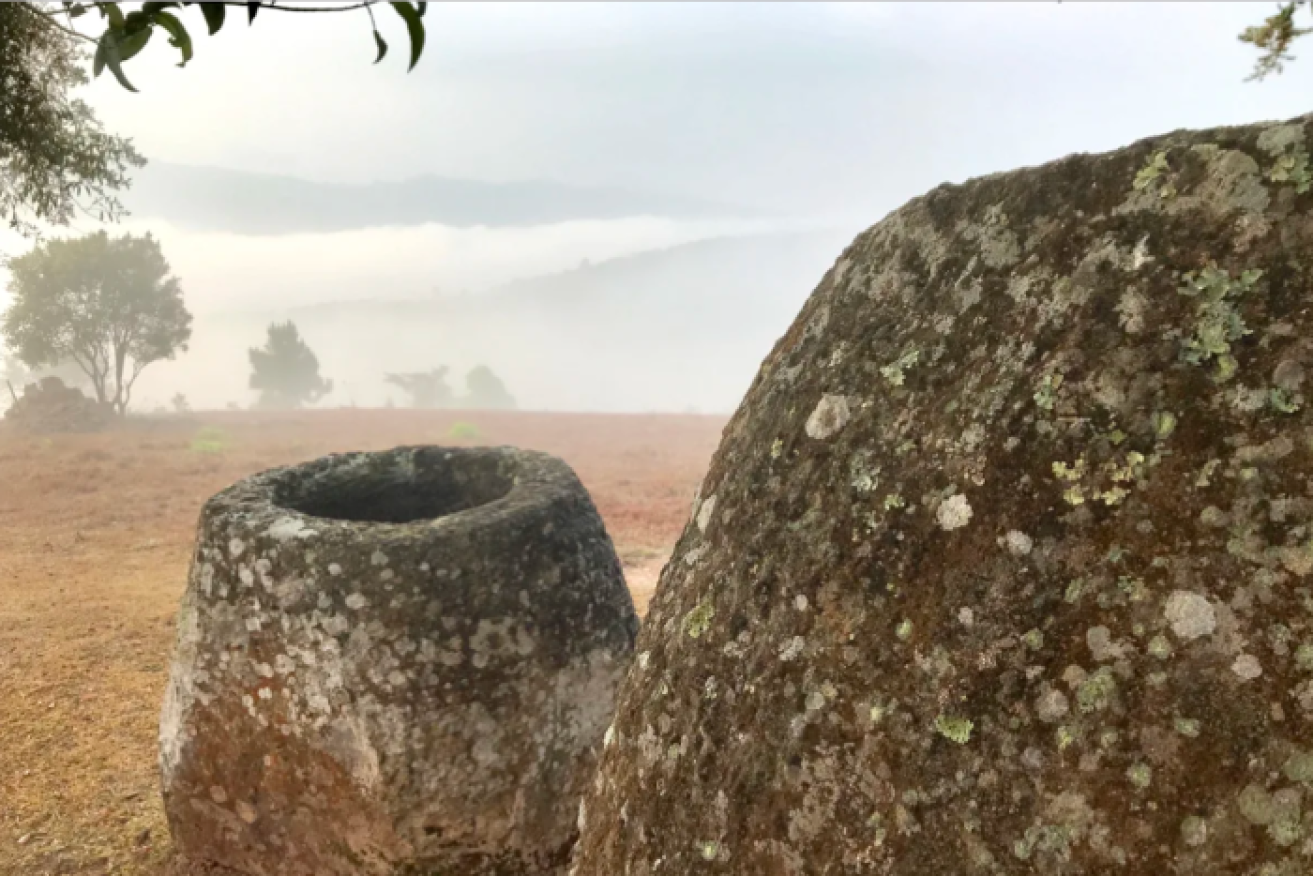Archaeologists discover more giant stone jars used to dispose of the dead in Laos

An Australian-led research team mapped 15 new sites in Laos where jars have been found. Photo: ANU
It is an archaeological mystery that has perplexed scientists for decades: which ancient civilisation carved huge stone jars for disposing its dead at sites across Laos?
Experts believe the jars are related to an ancient burial practice, but no-one is certain about their original purpose or the people who brought them there.
Earlier this year, a joint Australian-Lao archaeological team used geospatial mapping to uncover several previously undiscovered jars.
“You start seeing patterns as to where the jars are sitting in the landscape … along saddles or they sit in prominent positions,” said Nick Skopal, a PhD student at the Australian National University.
Mr Skopal and Lao archaeologist Souliya Bounxayhip mapped 15 new sites and their surroundings, adding to a database of more than 100 known jar sites.

Australian archaeologist Nick Skopal trekked through the jungle in Laos to study the jars. Photo: Nick Skopal
The jars are scattered across hundreds of square kilometres in Laos’s north-east.
“What was really interesting is they [the burial jars] seem to have extensive views of farmland or lower-lying area, which suggests potentially that’s where the habitation sites could be,” Mr Skopal said.
So far, archaeologists have found few signs of human habitation near the jars, but that could be about to change.
“We did find a potential habitation site associated with one jar site — there was large pottery scatter,” Mr Skopal said.
The mapping was part of a wider research effort, led by the Australian National University and the University of Melbourne, in a collaboration with Laos’s Government.
While previous expeditions have revealed details about the burial rituals, the question of who these people were remains a mystery.

Archaeologists from Australia and Laos uncovered new jar sites earlier this year. Photo: ANU
“You would have to think that they lived quite close by because there’s an enormous investment to carve these jars and locate them,” said the University of Melbourne’s Louise Shewan, a co-leader of the project.
“But we still don’t know how they got from the quarry over eight to 10 kilometres away to their final resting places, and indeed when that happened.”
Archaeologists battle bombs and leeches to find jars
The quest to solve the mystery of who carved the giant stone jars of Laos is archaeology as non-archaeologists might like to imagine it — a last bastion of adventure and exploration.

The expedition team had to watch out for leeches and Vietnam-era bombs during their trek.
Photo: Nick Skopal
“It’s very rare to still be able to trek through the jungle and find lost sites, so there definitely is that romance with it,” Mr Skopal told the ABC.
“I have to admit, getting ticks and leeches all over you isn’t that romantic.”
Add to that list snakes and bombs.
Laos is the most heavily bombed country in the world, thanks to the CIA’s secret campaign on the sidelines of the Vietnam War.
“One of the issues we have is there’s still a lot of … cluster bombs left out in the jungle or the farmlands,” Mr Skopal said.
“So there are instances where you will see the cluster bombs and you have to be very careful where you step.”

Archaeologists had to keep an eye out for cluster bombs left over from the Vietnam War. Photo: ANU
However, that CIA history has reaped some unexpected rewards.
One of the previously undocumented sites the team mapped in February came to light when a Vietnam-era CIA pilot mentioned huge jars to an American researcher.
There was no record of the site in the official database kept by the Laos Government and UNESCO.
But after a sweaty trek, guided by locals who remembered the American planes, Mr Skopal and Lao colleagues found a number of stone jars near the former secret airbase.
“It was quite spectacular. The jars were down below and you could see where the CIA base was up above, where the cliff faces were,” he said.
A soil clock and human teeth could unlock the mystery
The secrets of the jars are being tackled from several angles.
In addition to their mapping project, the Australian team took soil samples from beneath the jars and will apply a process called optically stimulated luminescence.
“This is a technique that basically allows you to divine the last time the ground underneath the jar saw light,” ANU archaeologist Dougald O’Reilly said.

Experts are analysing the soil under the jars to learn when they were put there. Photo: ANU
“Once the jar was placed there, obviously no light is going to be hitting that, so it sort of sets the clock.”
Previous dating of bone and charcoal from the jar sites suggests the burials occurred between the 9th and 12th century.
That could mean they were connected to the Angkorian empire, but it is not clear if the jars were carved then or earlier.
Dr Shewan said human teeth found nearby could also unlock the secrets of the jars.

Human teeth found in the jars may offer clues about where the people came from. Photo: Nick Skopal
“Teeth mineralise at different ages, so if we analyse different teeth we can get a snapshot of life from zero to approximately 16 years of age,” Dr Shewan told the ABC.
Yet another puzzle is the existence of tiny ceramic jars found near the giant stone jars and a single piece of refined ceramic that is at odds with the other rough pottery baked in an open fire.
Technology helps bring these ancient mysteries to light, but so does imagining how things must have looked before fading over thousands of years.
“This is a sort of a running theme — the use of white in the mortuary activity. Most of these jars are either sandstone or limestone and when they were originally carved, they would have been really bright white,” Dr O’Reilly said.
The Australian-led researchers will return to Laos next year for their final trip under their current five-year grant.
Mr Skopal is already keen to get back to Laos.
“You can still hear the monkeys in the jungle and trekking up the waterfall,” he said.
“It was pretty amazing, because there was still very pristine forest, so definitely a good adventure.”

The archaeologists hope to return to the sites to learn more about the jars. Photo: ANU







